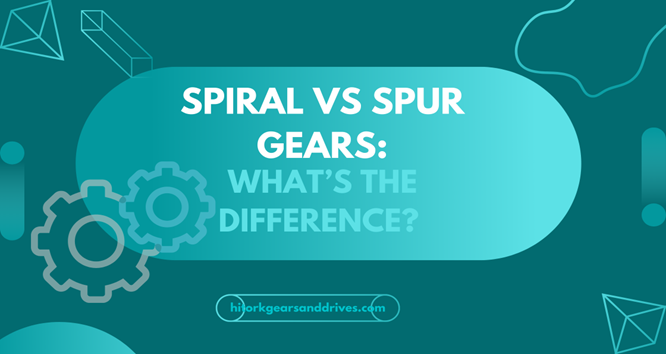
Spiral vs Spur Gears: What’s the Difference?
Many of the machines we use on a daily basis, including cars, airplanes, industrial equipment, and even home appliances, are powered by gears. Although the fundamental function of all gears is to transfer motion and power between rotating shafts, the performance of each gear is greatly influenced by the design of its teeth. The most often compared gear types are spur and spiral gears.
Introduction to Spur Gears
Spur gears are the simplest and oldest type of gears. They have straight teeth that are cut parallel to the gear’s axis of rotation. When two spur gears mesh, their teeth engage simultaneously across the whole width, resulting in direct transfer of motion.
Key Characteristics of Spur Gears:
Straight-cut teeth, aligned parallel to the axis.
Simple design, easy to manufacture.
Operate efficiently at moderate speeds.
Most common in basic machinery and consumer products.
Example Applications:
Clocks and simple timing devices
Conveyor systems
Low to medium-speed industrial machines
Household appliances
Introduction to Spiral Gears
Spiral gears, often confused with helical gears, have teeth cut at an angle, forming a spiral curve. Unlike spur gears, spiral gears don’t engage all at once — the contact starts at one end and gradually spreads across the tooth. This creates smoother and quieter motion.
Key Characteristics of Spiral Gears:
Curved teeth arranged in a spiral fashion.
Gradual tooth engagement reduces noise and vibration.
Capable of handling higher loads and speeds.
Require more complex manufacturing compared to spur gears.
Example Applications:
Automobiles (transmissions, steering systems)
Aerospace machinery
High-performance industrial equipment
Power tools and robotics
Spiral vs Spur Gears: The Core Differences
Advantages of Spur Gears
Simple Design – Easy to understand, design, and repair.
High Efficiency – Minimal sliding ensures very little power loss.
Cost-Effective – Cheaper to manufacture compared to spiral gears.
Reliable Performance – Works well in light to moderate duty machinery.
Advantages of Spiral Gears
Smooth Operation – Gradual tooth engagement reduces shocks.
Quieter Performance – Lower noise and vibration make them perfect for automotive and aerospace applications.
High Load Capacity – Can handle heavier loads and transmit higher torque.
Durability – Reduced wear due to stress distribution
Which One Should You Choose?
Choosing between spur and spiral gears depends on your application needs:
If you’re working on a low-speed, budget-friendly project where noise isn’t a big concern (like simple machinery), spur gears are the better option.
If you need quiet, smooth, and durable performance under high speed or heavy load conditions, spiral gears are the ideal choice.
Real-World Example
Imagine the difference between a wall clock and a car transmission:
The clock uses spur gears because it operates at low speeds, doesn’t carry heavy loads, and noise is not a critical issue.
A car transmission uses spiral (or helical) gears to ensure smooth, quiet performance at high speeds and under significant torque loads.
This practical comparison highlights why the right gear choice is crucial.

Spiral vs Spur Gears: Quick Comparison Table
|
Feature |
Spur Gears |
Spiral Gears |
|
Tooth Design
|
Straight, parallel |
Curved, spiral-shaped |
|
Load Distribution
|
Sudden, uneven |
Gradual, even |
|
Noise & Vibration
|
High at speed |
Low at speed |
|
Efficiency
|
98–99% |
95–97% |
|
Manufacturing
|
Simple, low cost |
Complex, higher cost |
|
Load Capacity
|
Moderate |
High |
|
Durability
|
Lower at high speeds |
High |
|
Applications |
Clocks, conveyors, tools |
Cars, aircraft, power tools |
Final Thoughts
Both spur gears and spiral gears play essential roles in engineering and everyday life. The choice between them depends on factors like load, speed, noise, efficiency, and budget. Spur gears are simple, cost-effective, and efficient at moderate speeds, while spiral gears provide smooth, quiet, and durable performance under demanding conditions.
Why Choose Hitork?
Hitork is distinguished by its dedication to high-quality materials, consistent quality, and precise engineering. Strict quality control is used throughout the manufacturing process to guarantee long-lasting performance, high efficiency, and seamless operation. With the help of knowledgeable technical support, the company provides customization options to satisfy particular industrial needs. For industries looking for dependability, innovation, and value in gear manufacturing, Hitrok is the go-to option because of its track record of producing strong, high-performing components
FAQs on Spiral vs Spur Gears
Q1. Are spiral gears and helical gears the same?
Not exactly. Spiral gears are often a type of helical gear with curved teeth, while helical gears typically have straight-slanted teeth. Both share similar benefits of smoother engagement compared to spur gears.
Q2. Why are spur gears more efficient than spiral gears?
Because spur gears have straight teeth, they experience minimal sliding friction during engagement. Spiral gears, on the other hand, have angled teeth that create more sliding, reducing efficiency slightly.
Q3. Can spur gears replace spiral gears?
Not always. Spur gears can replace spiral gears in low-speed, low-load applications, but they are not suitable for high-speed, heavy-load, or noise-sensitive environments.
Q4. Which gear type is better for automotive use?
Spiral gears are preferred in automobiles because they reduce noise, increase durability, and handle higher loads effectively.
Q5. Which one lasts longer: spur or spiral gears?
Spiral gears generally last longer under heavy loads and high speeds due to better load distribution, while spur gears may wear faster in such conditions.

